On May 26th, fifty-four school girls stand on a train platform at Shinjuku Station awaiting their train and smiling. As the train rounds its final corner and enters the station, the fifty-four girls, holding hands, jump simultaneously in front of the train, committing mass suicide. As the police begin to investigate, the possibility that this might be a suicide cult is suggested, but the Chief of Police shoots down the idea in fear of copycats. The death toll begins to rise as a website tracks the number of deaths… before they’ve happened. Writer/director Sion Sono (Noriko’s Dinner Table) opens a disturbing dialogue about Japan’s high suicide rate with the film Suicide Club (Suicide Circle): Unrated Version from TLA Releasing.
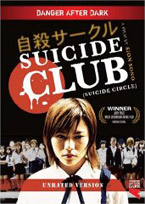 Stats
Stats
DVD: Suicide Club (Suicide Circle): Unrated Version
Release Date: 11/18/2003
Release Studio: TLA Releasing
MSRP: $14.99
Audio: Japanese 2.0 DD
Subtitles: English
Episodes: 1
Runtime: 94mins
Extras: Theatrical Trailer, Image Gallery, Trailers
Notes: Review is based on a Retail purchased copy of the final product.
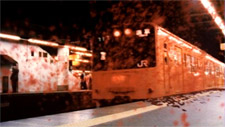 As passengers waiting for the subway train are sprayed by blood, a white bag is left at the scene of the mass suicide. Meanwhile, the quintet of J-pop 12-year-old singers in the group Dessert sing their hit song “Mail Me” for the crowd. At a hospital, two nurses listen to the radio and sing along. One leaves to get some food but doesn’t come back. Getting worried, Nurse Yoko Kawaguchi calls down to the security office to ask Jiro if Sawada had returned yet. However, Jiro hasn’t seen her since she left. A little later, the security guard heads up to Nurse Kawaguchi’s floor to check on her, but the nurse is nowhere to be found and the window has been left open. As Jiro closes the window and turns to leave, the power cuts out. Jiro calls out into the darkness and Nurse Sawada enters the room with food. Sawada asks if Yoko has left, and Jiro guesses that she had gone home. With that done, Sawada offers Jiro Yoko’s food, opens the window, and steps out herself. A white bag with blood all over it slides across the ground.
As passengers waiting for the subway train are sprayed by blood, a white bag is left at the scene of the mass suicide. Meanwhile, the quintet of J-pop 12-year-old singers in the group Dessert sing their hit song “Mail Me” for the crowd. At a hospital, two nurses listen to the radio and sing along. One leaves to get some food but doesn’t come back. Getting worried, Nurse Yoko Kawaguchi calls down to the security office to ask Jiro if Sawada had returned yet. However, Jiro hasn’t seen her since she left. A little later, the security guard heads up to Nurse Kawaguchi’s floor to check on her, but the nurse is nowhere to be found and the window has been left open. As Jiro closes the window and turns to leave, the power cuts out. Jiro calls out into the darkness and Nurse Sawada enters the room with food. Sawada asks if Yoko has left, and Jiro guesses that she had gone home. With that done, Sawada offers Jiro Yoko’s food, opens the window, and steps out herself. A white bag with blood all over it slides across the ground.
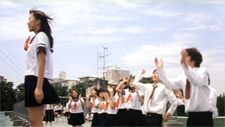 The Chief of Police has called his detectives together to investigate the mass suicide at the train station. Detective Shibusawa (Masatoshi Nagase; Electric Dragon 80000V) suggests that it might be a suicide cult, but the Chief dismisses the idea quickly. Detective Kuroda (Ryo Ishibashi; Audition, The Grudge) starts to ask questions to find the connection, but the Chief is determined to not consider this a crime. Shibu receives a phone call that gains the attention of the staff: A hacker calling herself ‘The Bat’ (j-idol/actress Yoko Kamon) has been following the suicide discussions online. This includes a website that is tracking the deaths… before they happen. The Bat leaves the police the tracking website and a BBS website she will be posting on as she continues her investigation. So far, the only lead is a website with red and white circles: red for the death of a woman, white for the death of a man. As the hacker hangs up, the police recieve reports of two more deaths at a hospital.
The Chief of Police has called his detectives together to investigate the mass suicide at the train station. Detective Shibusawa (Masatoshi Nagase; Electric Dragon 80000V) suggests that it might be a suicide cult, but the Chief dismisses the idea quickly. Detective Kuroda (Ryo Ishibashi; Audition, The Grudge) starts to ask questions to find the connection, but the Chief is determined to not consider this a crime. Shibu receives a phone call that gains the attention of the staff: A hacker calling herself ‘The Bat’ (j-idol/actress Yoko Kamon) has been following the suicide discussions online. This includes a website that is tracking the deaths… before they happen. The Bat leaves the police the tracking website and a BBS website she will be posting on as she continues her investigation. So far, the only lead is a website with red and white circles: red for the death of a woman, white for the death of a man. As the hacker hangs up, the police recieve reports of two more deaths at a hospital.
At the hospital, the police find the white bag and open it. The disgusting contents lead Kuroda and Shibu to the train station the next day to see if another bag had been found at the location. Their hunch is right and inside the bag they find a roll of human skin sewen together. The coroner suggests that the skin was from the victims while they were still alive. Kurodo returns home to see his family and forget the horrors of the day. Calling a family meeting, his plan gets lost as everyone focuses on watching Dessert perform on TV.
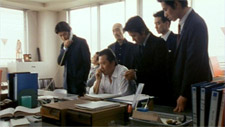 May 28th arrives as two school girls haul trash up to the roof of the building. The news of the suicides has spread quickly and different students tease each other about forming suicide clubs so that they can go together. The boys antagonize the girls and expand the idea to make it a large suicide group whose members have sex and then die by a drug overdose. Everyone laughs at the idea and one of the trash-hauling girls volunteers to throw herself off the building right then. Everyone laughs even more and runs to the ledge to cheer her on. However, the girl doesn’t act quickly and this drives the entire suicide club to join her on the ledge to jump. As they hold hands and get ready to go, they sing the same song the original fifty-four sang before plummeting to their deaths. Only three students remain on the ledge, shocked by the fact that the others leapt off. One girl, confused and lost in the moment, grabs the only guy still standing on the ledge. Against his will, she pulls him off the ledge with her. Students and teachers run to the roof top only to be greeted by the remaining suicide club member. She proudly announces that they are the charter members of the suicide club before leaping to her own death. Kuroda wants to open a criminal investigation, starting with the train deaths, but fellow detective Murata (Akaji Maro) shoots down the suggestion because no crime has been commited. ‘It’s only a fad,’ he theorizes.
May 28th arrives as two school girls haul trash up to the roof of the building. The news of the suicides has spread quickly and different students tease each other about forming suicide clubs so that they can go together. The boys antagonize the girls and expand the idea to make it a large suicide group whose members have sex and then die by a drug overdose. Everyone laughs at the idea and one of the trash-hauling girls volunteers to throw herself off the building right then. Everyone laughs even more and runs to the ledge to cheer her on. However, the girl doesn’t act quickly and this drives the entire suicide club to join her on the ledge to jump. As they hold hands and get ready to go, they sing the same song the original fifty-four sang before plummeting to their deaths. Only three students remain on the ledge, shocked by the fact that the others leapt off. One girl, confused and lost in the moment, grabs the only guy still standing on the ledge. Against his will, she pulls him off the ledge with her. Students and teachers run to the roof top only to be greeted by the remaining suicide club member. She proudly announces that they are the charter members of the suicide club before leaping to her own death. Kuroda wants to open a criminal investigation, starting with the train deaths, but fellow detective Murata (Akaji Maro) shoots down the suggestion because no crime has been commited. ‘It’s only a fad,’ he theorizes.
May 29th begins with a painful landing as a teen named Masa leaps off a building only to land on top of his girlfriend, Mitsuko (Saya Hagiwara). Disgusted with her boyfriend, she leaves him on the ground and enters a cafe to order coffee. The police investigate Mitsuko thoroughly due to her connection with Masa (who died shortly after jumping). Murata questions Mitsuko while the coroner confirms that one of the patches of skin from the roll is from the suicide jumper. Meanwhile, The Bat starts to post questions and theories regarding the suicide club to see if she’s correct, and Kuroda’s son shows him a website a friend passed to him about the suicides.
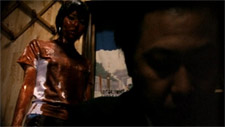 Jisatsu Saakuru (Suicide Circle) shows off Sion Sono’s talents as a writer and director with this thought provoking J-horror title that was shot in the span of two weeks. The puzzle grows larger as Kuroda gains access to the website his son showed him, The Bat finds herself the target of a fanatical group claiming to be the source of the suicide movement, and the real people behind the deaths starts to contact Kuroda to see if he can decipher their clues in time. However, just when you think the puzzle is solved, the rubik’s cube of the true mystery shows its form. The film had a subplot involving a security guard that was removed, so the lengthy security guard scenes left in make little sense except when the two nurses jump out the window. Those that followed the J-rock group Scanch or his later solo career will enjoy the appearance of Rolly as Genesis, the psychotic leader of a group claiming to be the Suicide Club so that it can be immortalized in the history books. Sion Sono’s Suicide Circle is the first of a now trilogy of films exploring the before and after events of the film in addition to his novel Jisatsu Saakuru: Kanzenban. Noriko’s Dinner Table explores details before and after Suicide Circle while a third film plans to answer even more questions. The cast is largely filled with unknowns with the exception of a few actors. Ryo Ishibashi brings his commanding talent to the film to lead the first act as Kuroda explores the series of suicide deaths. Masatoshi Nagase slowly rises and takes command of the second half of the film as Shibusawa becomes concerned about Mitsuko. And Saya Hagiwara deserves a mention; her character mixes loathing with concern extremely well as she eventually finds herself exploring the death of her boyfriend.
Jisatsu Saakuru (Suicide Circle) shows off Sion Sono’s talents as a writer and director with this thought provoking J-horror title that was shot in the span of two weeks. The puzzle grows larger as Kuroda gains access to the website his son showed him, The Bat finds herself the target of a fanatical group claiming to be the source of the suicide movement, and the real people behind the deaths starts to contact Kuroda to see if he can decipher their clues in time. However, just when you think the puzzle is solved, the rubik’s cube of the true mystery shows its form. The film had a subplot involving a security guard that was removed, so the lengthy security guard scenes left in make little sense except when the two nurses jump out the window. Those that followed the J-rock group Scanch or his later solo career will enjoy the appearance of Rolly as Genesis, the psychotic leader of a group claiming to be the Suicide Club so that it can be immortalized in the history books. Sion Sono’s Suicide Circle is the first of a now trilogy of films exploring the before and after events of the film in addition to his novel Jisatsu Saakuru: Kanzenban. Noriko’s Dinner Table explores details before and after Suicide Circle while a third film plans to answer even more questions. The cast is largely filled with unknowns with the exception of a few actors. Ryo Ishibashi brings his commanding talent to the film to lead the first act as Kuroda explores the series of suicide deaths. Masatoshi Nagase slowly rises and takes command of the second half of the film as Shibusawa becomes concerned about Mitsuko. And Saya Hagiwara deserves a mention; her character mixes loathing with concern extremely well as she eventually finds herself exploring the death of her boyfriend.
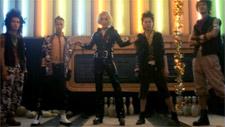 Suicide Club (Suicide Circle): Unrated Version is a sharp social commentary on Japanese society and is not for the casual movie fan. The graphic horror can be a bit b-movie cheesy at times, but it does get its point across very well without having the audience mistakenly laugh. The video is clean, although TLA Releasing has changed the video aspect to fit widescreen TV sets by stretching the image vertically very slightly. The subtitles, overall, aren’t bad, but there are some annoyances. The subtitles are a bit selective on what is translated, which leaves some side conversations during pans across group discussions and signs related to the story untranslated. You don’t miss much, but it wouldn’t have hurt to add a few more details into the film when no major characters are talking during. The DVD extras are a photo gallery of set stills and a hardsub translation of the original theatrical trailer. Suicide Club (Suicide Circle): Unrated Version is a great film to see, but it isn’t always clear on getting its message; this leaves questions to be found in the novel, manga, and sequel films. The sequel film (Noriko’s Dinner Table) was recently released in May 2008 and if the novel could find its way to an English-translated release, the series could become very popular in the U.S., just as Ringu and Tomie have with their multiple-media-format releases.
Suicide Club (Suicide Circle): Unrated Version is a sharp social commentary on Japanese society and is not for the casual movie fan. The graphic horror can be a bit b-movie cheesy at times, but it does get its point across very well without having the audience mistakenly laugh. The video is clean, although TLA Releasing has changed the video aspect to fit widescreen TV sets by stretching the image vertically very slightly. The subtitles, overall, aren’t bad, but there are some annoyances. The subtitles are a bit selective on what is translated, which leaves some side conversations during pans across group discussions and signs related to the story untranslated. You don’t miss much, but it wouldn’t have hurt to add a few more details into the film when no major characters are talking during. The DVD extras are a photo gallery of set stills and a hardsub translation of the original theatrical trailer. Suicide Club (Suicide Circle): Unrated Version is a great film to see, but it isn’t always clear on getting its message; this leaves questions to be found in the novel, manga, and sequel films. The sequel film (Noriko’s Dinner Table) was recently released in May 2008 and if the novel could find its way to an English-translated release, the series could become very popular in the U.S., just as Ringu and Tomie have with their multiple-media-format releases.
